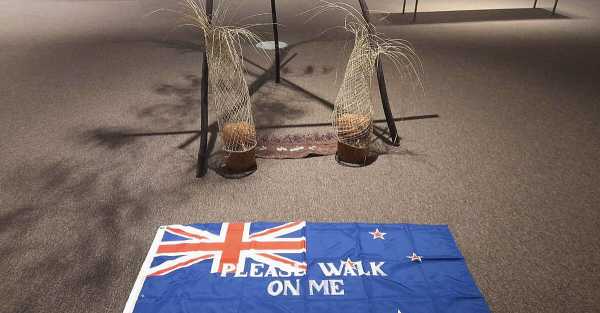
A New Zealand flag bearing the words “Please Walk on Me” that was placed on the floor of an art gallery has been removed again following public outrage, 30 years after similar protests led to the removal of the same piece of art.
Nelson's Suter Art Gallery says it has removed a work by Maori artist Diane Prince due to rising tensions and safety concerns.
The incident is reminiscent of a 1995 incident when an Auckland gallery pulled a work from an exhibition following a public backlash.
This time, the flag was supposed to remain on display for five months. Instead, it only lasted 19 days, reigniting old debates in New Zealand about artistic expression, national symbols and the country's colonial history.
Police told The Associated Press they were looking into “several” complaints about the exhibit.
The piece, titled 'Future Flag', features a New Zealand flag laid out on the floor with the words 'Please Walk on Me' stencilled on it.
The work was part of the exhibition 'Diane Prince: Artist Activist' and was intended to provoke reflection on the lives of Maori people since the colonisation of New Zealand by Britain in the 19th century.
Ms Prince created the piece in 1995 in response to government policies that limited compensation to Maori people for historical land loss.
“I have no attachment to the New Zealand flag,” she told Radio New Zealand in 2024. “I don't identify as a New Zealander. I identify as Māori.”
In recent decades, New Zealand has increasingly acknowledged its colonial past. However, there has been little appetite among successive governments to sever remaining constitutional ties with Britain or to change the design of the flag.
New Zealand is one of the countries where desecration of the national flag is considered taboo and is illegal. Damaging the flag in public with the intent to insult it can result in a fine of up to NZ$5,000, but prosecutions are rare.
As in the United States and other countries, the flag is a symbol of military service for some. But for others, especially some Maori, it is a reminder of the loss of land, culture and identity.
Protests against the artwork in Nelson, home to 55,000 people, included videos posted by local resident Ruth Tipu, whose grandfather served in a Maori army battalion during World War II.
In one clip, she picks up a flag from the floor and drapes it over another piece of art, an act Ms Tipu says she intends to continue every day.
A veterans group also condemned the piece as “disgraceful” and “offensive.” City Councilman Tim Skinner said he was “horrified” by the work's placement.
However, others have backed it up. Nelson Deputy Mayor Rohan O'Neill-Stevens posted on social media “in a strong defence of artistic expression and the right of all of us to have art that provokes debate and challenges”.
The work may have been intended to be controversial, and during the opening days of the exhibition, the Suter gallery defended its inclusion. However, in a statement on its Facebook page on Thursday evening, it said that “a dramatic escalation in the tone and nature of the debate, far beyond the bounds of respectful debate,” was the reason for the flag’s removal.
“This should not be taken as an assessment of the artwork or the artist's intention,” the statement said.
Sourse: breakingnews.ie






